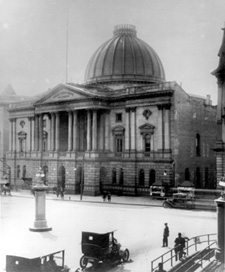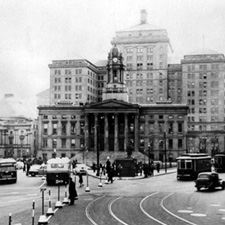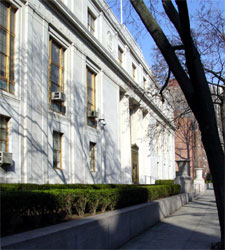

The Appellate Division, Second Department, has had three homes in its more than 100-year existence, all in historic downtown Brooklyn.
The Old Kings County Courthouse 1896-1903 (Photo courtesy of the Brooklyn Historical Society)
 The court first sat in the old Kings County Courthouse, located on what is now the site of Brooklyn Law School at the southwest corner of the intersection of Joralemon Street and Boreum Place in downtown Brooklyn. Change was in the air in 1894 and 1895. In addition to the Constitutional Convention and the alterations it brought, in those years the City of Brooklyn annexed the remaining Kings County towns of Flatbush, New Utrecht, Gravesend, and Flatlands. When this was done the whole of Kings County had become identical with the City of Brooklyn and a separate county government with its own officers was rendered unnecessary. The end of the need for county government came on December 31, 1895, and coincidentally the Constitution of 1894 went into effect on the following day. Thus the chamber of the former Kings County Board of Supervisors, which went out of existence with the end of county government, became available and it was redecorated for use as the courtroom for the Appellate Division, Second Department.
The court first sat in the old Kings County Courthouse, located on what is now the site of Brooklyn Law School at the southwest corner of the intersection of Joralemon Street and Boreum Place in downtown Brooklyn. Change was in the air in 1894 and 1895. In addition to the Constitutional Convention and the alterations it brought, in those years the City of Brooklyn annexed the remaining Kings County towns of Flatbush, New Utrecht, Gravesend, and Flatlands. When this was done the whole of Kings County had become identical with the City of Brooklyn and a separate county government with its own officers was rendered unnecessary. The end of the need for county government came on December 31, 1895, and coincidentally the Constitution of 1894 went into effect on the following day. Thus the chamber of the former Kings County Board of Supervisors, which went out of existence with the end of county government, became available and it was redecorated for use as the courtroom for the Appellate Division, Second Department.
The first session of the court was held in the former Supervisors' Chamber on January 6, 1896. At 10 a.m. on that day the proclamation was made and Presiding Justice Charles F. Brown, and Associate Justices Calvin E. Pratt, Edgar M. Cullen, Willard Bartlett, and Edward S. Hatch took the bench. Joseph A. Burr, the President of the Brooklyn Bar Association, addressed the court, the calendar was called, and argument was held. Not only was this the first meeting of a new court, in a new courtroom, but the Justices also had a new look. It was on that day that the Justices of the Supreme Court first wore judicial gowns while on the bench. The New York Law Journal observed that the decision to wear judicial gowns did not spring from a "love of mere pomp," but rather "from a deliberate conviction that a certain amount of ceremony and symbolism…may have real utility in constantly reminding the Bench and Bar alike of the obligation of conscientious and decorous official conduct." The first appeal that the court decided was Kingsland Land Co. v Newman, reported by Marcus T. Hun as the first case in the first series of the Appellate Division reports. It involved an action brought against the endorser of a promissory note on an appeal from what was then called the Kings County Circuit.
The use of a courtroom in the Kings County Courthouse was a temporary measure. Unlike the former General Term, whose judges sat both at the trial level and on appellate panels in courthouses in each of the Judicial Districts making up the Judicial Department, the Appellate Division was intended to be a permanent and independent court with full-time Justices and staff. It needed its own courtroom, clerk's office, and chambers for its Justices.
The Brooklyn Borough Hall 1903-1938 (Photo courtesy of The Office of the Brooklyn Borough President)
 The court's second home was in what is now known as Borough Hall, a Greek revival building, designed in 1835 and completed in 1849 for use as the City Hall of the City of Brooklyn, and located on the triangle of land bounded by Joralemon, Court, and old Fulton Streets. The building was home to the Mayor and Common Council of the City of Brooklyn when, on the morning of February 26, 1895, a lighted gas jet in a small, third-floor closet filled with waste paper caused a fire that destroyed the clock and bell tower, gutted the top floor of the building, and ruined the walls and ceiling of the Common Council chamber by water damage. In January 1898 the independent City of Brooklyn was consolidated into the City of New York and Kings County became the Borough of Brooklyn. Like county government before it, Brooklyn City government ended with consolidation. Space in the damaged, former Brooklyn City Hall, now known as the Borough Hall, became available, but had to be redesigned, repaired, and reconfigured as a courthouse for the Appellate Division, Second Department. Beginning in 1902 the old Common Council chamber was converted into a courtroom in the beaux-arts style under the direction of architect Axel Hedman. In July 1903 the Court issued an order altering the place of its sittings to the new ceremonial courtroom in the Borough Hall and moved to the chambers prepared for it on the third and fourth floors of that building.
The court's second home was in what is now known as Borough Hall, a Greek revival building, designed in 1835 and completed in 1849 for use as the City Hall of the City of Brooklyn, and located on the triangle of land bounded by Joralemon, Court, and old Fulton Streets. The building was home to the Mayor and Common Council of the City of Brooklyn when, on the morning of February 26, 1895, a lighted gas jet in a small, third-floor closet filled with waste paper caused a fire that destroyed the clock and bell tower, gutted the top floor of the building, and ruined the walls and ceiling of the Common Council chamber by water damage. In January 1898 the independent City of Brooklyn was consolidated into the City of New York and Kings County became the Borough of Brooklyn. Like county government before it, Brooklyn City government ended with consolidation. Space in the damaged, former Brooklyn City Hall, now known as the Borough Hall, became available, but had to be redesigned, repaired, and reconfigured as a courthouse for the Appellate Division, Second Department. Beginning in 1902 the old Common Council chamber was converted into a courtroom in the beaux-arts style under the direction of architect Axel Hedman. In July 1903 the Court issued an order altering the place of its sittings to the new ceremonial courtroom in the Borough Hall and moved to the chambers prepared for it on the third and fourth floors of that building.
The court's first sitting in the new space in the Borough Hall was held on Monday, September 28, 1903. Court opened at 1 p.m. with the call of a motion calendar. The courtroom was filled with lawyers and a few spectators and the proceedings had not been long in progress when a stout woman, "the sole representative of her sex in the court room," made her way to the counsel table and stood staring fixedly at Presiding Justice Goodrich. A court officer walked to where she stood, took her by the arm, and motioned her to a chair. She shook off his grasp and stood resolutely before the five "astonished" Justices. A motion had just been called and a young lawyer had begun to address the court concerning it, but the Presiding Justice interrupted him and asked "What is it you will have, madam?" She said that she was Ann Nolan, the plaintiff in the case that had just been called. "Have you no lawyer in the court room?" asked the Presiding Justice. Mrs. Nolan said she had but preferred to state her own case. After Mrs. Nolan told her story, "a very unusual and almost unprecedented proceeding before the Appellate Division," her lawyer rose to say that he could do nothing with his client, and with that the court took her motion for an enlargement of time to print the record on submission. With this intrusion of a female litigant into the then virtually all male world of appellate practice, the Borough Hall courtroom was inaugurated. It was to be the court's home for exactly the next 35 years.
By the 1920s, space in the Borough Hall had become inadequate to meet the needs of the court and then Presiding Justice Edward Lazansky began to urge the construction of an independent courthouse for its use. With the support of Mayor LaGuardia, the Board of Estimate of the City of New York voted to provide a new courthouse.
The Monroe Place Courthouse 1938-Present
 A site was selected in a residential area at the northwest corner of the intersection of Monroe Place and Pierrepont Street in what is presently the Brooklyn Heights Historic District. The location is the highest point in Brooklyn Heights and was once known as Clover Hill. During the Revolutionary War American troops began to build an earthen fort on the spot as part of the defenses of Brooklyn. After the American evacuation of Long Island, the fort fell into the hands of the British, who redesigned and completed it during their occupation of New York. "Brooklyn Fort" mounted 18 cannon and was 450 feet square with walls that rose 45 feet above a 20-foot deep ditch. When peace came, the fort reverted to the possession of the farmers on whose land it stood. Over the next 50 years they dismantled it as best they could but parts of the ramparts and ditch were visible until 1836 when the present streets were put through and houses and a church occupied the corner.
A site was selected in a residential area at the northwest corner of the intersection of Monroe Place and Pierrepont Street in what is presently the Brooklyn Heights Historic District. The location is the highest point in Brooklyn Heights and was once known as Clover Hill. During the Revolutionary War American troops began to build an earthen fort on the spot as part of the defenses of Brooklyn. After the American evacuation of Long Island, the fort fell into the hands of the British, who redesigned and completed it during their occupation of New York. "Brooklyn Fort" mounted 18 cannon and was 450 feet square with walls that rose 45 feet above a 20-foot deep ditch. When peace came, the fort reverted to the possession of the farmers on whose land it stood. Over the next 50 years they dismantled it as best they could but parts of the ramparts and ditch were visible until 1836 when the present streets were put through and houses and a church occupied the corner.
Construction began on March 1, 1937, and the new courthouse was completed and officially opened on September 28, 1938, at a cost slightly exceeding $1,500,000. Although there were no formal opening ceremonies, the event was marked by the presence on the bench of all eight of the then Justices of the court, making it the only known occasion in which the court has sat en banc.
The court's third home was designed by the Brooklyn architectural firm of Slee & Bryson. The building is of a classical revival style that flourished in the Great Depression and is three stories high, clad in white limestone with a pink granite base. Two fluted Doric columns stand at either side of the bronze entrance doorway and the ornamental grillwork over the lobby windows. A stepped parapet and four bas-relief, sculptural rondels at the third floor adorn the Monroe Place facade. The low height and restrained classical details of the courthouse allow it to harmonize with the nineteenth century buildings in the surrounding historic district.
The interior of the courthouse is also finished in the classical revival style. The imposing lobby has a coffered, vaulted ceiling that is supported by four green marble Ionic columns. There is extensive decorative bronze work on the doors, elevators, railings, and vents. The two-story courtroom is half-paneled in American walnut with acoustical stone from the level of the second floor to the coffered ceiling, which is accented with gold leaf. Four large bronze chandeliers light the room. The clerk's office, administrative offices, and lawyers' lounge complete the first floor. The lounge is notable for its collection of photographs of the Justices who have made up the bench of the court since its founding in 1896. The second and third floors contain nine walnut-paneled chambers for Justices, the court's library, and its consultation room. Hallways throughout the building have marble wainscoting and cork flooring.
When the present courthouse opened in 1938, a complement of 8 Justices and 63 staff were employed in the building, a total of 71. Today at full complement 22 Justices and more than 200 staff serve the court. Present staffing thus represents more than three times the number for which the building was originally designed. And while formerly all of the Justices of the Appellate Division had their principal chambers in the courthouse, currently less than a handful of associate justices and the Presiding Justice have their principal chambers there. The remaining associate justices have their principal chambers in the counties from which they were elected. To further reduce overcrowding, in 1997, the Court’s Law Department was moved to ancillary accommodations nearby.